Master Charcoal Grilling with Ease and Flavor
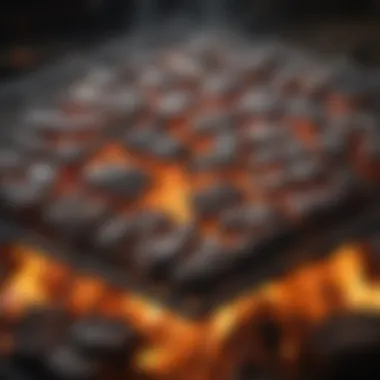
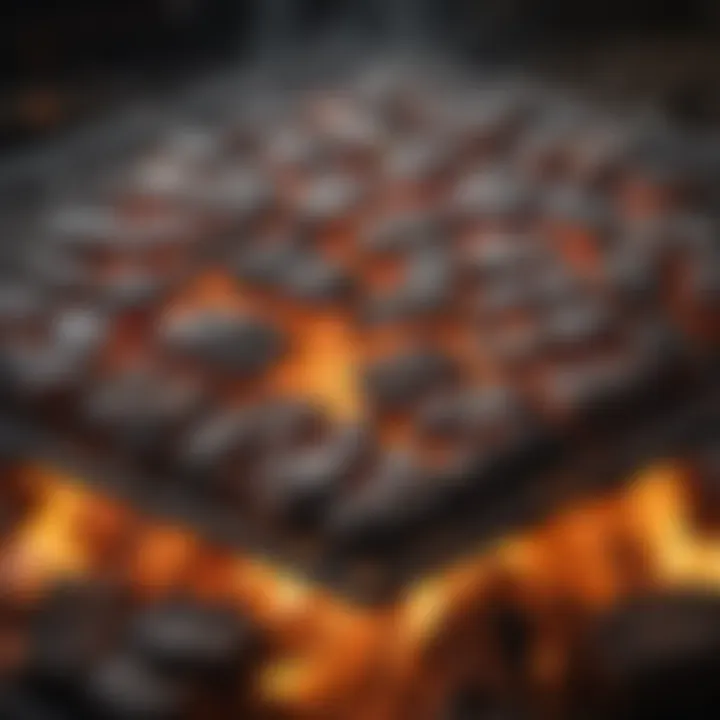
Intro
Charcoal grilling is an art that many home cooks aspire to master. There's something undeniably satisfying about that rich, smoky flavor that comes from cooking over an open flame. It’s more than just a way to prepare food; it’s a celebration of outdoor cooking and communal meals. However, igniting a charcoal grill correctly can seem daunting for those who are short on time or experience. Fear not, as this guide is designed to break down the complexities into bite-sized pieces.
In this exploration of charcoal grilling, we will discuss the fundamental materials and techniques needed to get that grill roaring efficiently. From the essential gear to the crucial steps that ensure safety and taste, readers will gain the confidence required to light up their grill and whip up delightful dishes without spending hours in front of the fire.
The section that follows will highlight a specific recipe aimed at making the grilling process not only simple but also delicious.
Understanding Charcoal Grilling
Grilling with charcoal has its unique appeal that many avid cooks appreciate. Not only does it enhance flavor, but it also provides a distinct cooking experience. Understanding charcoal grilling offers insight into why this method has remained a staple in backyards and cookouts around the world. In this section, we will explore the fundamental aspects that make charcoal an effective and popular choice for grilling.
The Basics of Charcoal as a Fuel Source
Charcoal is created by burning organic materials, mainly wood, in low-oxygen environments. This process, known as pyrolysis, removes water and volatile chemicals, leaving behind a dense, carbon-rich fuel. When properly ignited, charcoal can generate high heat, which is essential for searing meats and creating that beloved grilled flavor. One of the primary benefits of charcoal is its ability to reach higher temperatures compared to many gas alternatives, allowing for that perfect crispy exterior on steaks or burgers.
Types of Charcoal Available
When choosing charcoal for grilling, it's crucial to understand the varieties available, as each type has its benefits and drawbacks that can influence the cooking process.
Natural Lump Charcoal
Natural lump charcoal is made from pure wood, typically hardwoods like oak or hickory. The key characteristic of natural lump charcoal is its lack of additives; it burns cleaner with less ash. This type of charcoal delivers a robust smoky flavor, which many culinary enthusiasts prefer. It's also easy to light, a plus for those who want to get cooking without fuss. However, its downside is that it burns faster than briquettes, which may require more frequent additions for longer grilling sessions. Consider it a favorite for those aiming for high-heat grilling and a touch of authenticity in flavor.
Charcoal Briquettes
Charcoal briquettes are a widely used option, known for their convenience. Compressed sawdust mixed with binding agents produces a more uniform and consistent burn. This consistency is the primary advantage, as it allows for predictable heat levels during cooking. Additionally, briquettes are generally more affordable than their lump counterpart, making them a budget-friendly choice. On the flip side, many briquettes contain additives like lighter fluid, which can impact flavor. For a cook who prioritizes convenience, briquettes represent a practical way to approach grilling.
Flavored Charcoal Varieties
Flavored charcoal varieties come infused with different wood such as mesquite or applewood, which contribute unique aromas to your grilled food. This aspect is particularly appealing for those who want to experiment with different flavor profiles. The inclusion of these wood flavors allows griller to enhance dishes effortlessly without needing added wood chips or chunks. However, it may be less versatile in taste compared to natural lump charcoal or briquettes. Not everyone may appreciate the flavors imparted, so it's best to consider personal preferences before diving into this option.
Advantages of Charcoal Grilling
Charcoal grilling comes with several advantages. For one, it produces a high heat that can create a delicious sear on meat. Smoky flavors are a hallmark of charcoal grilling, with nuances that gas simply can't replicate. Plus, it’s perfect for those who enjoy the ritual of preparing and managing the fire, adding a sense of tradition and accomplishment.
"Grilling with charcoal is not just about cooking; it’s about embracing the whole experience of flavors and techniques."
In summary, understanding the nuances of charcoal grilling—from the types of charcoal to the flavorful potentials—provides all the groundwork necessary for effective grilling. Whether you're a seasoned pro or just starting out, mastering these elements will help elevate your grilling game.
Preparing the Grill
Preparing the grill is not just a matter of convenience; it lays the essential groundwork for successful cooking on a charcoal grill. A well-prepared grill ensures even cooking, enhances flavors, and reduces the risk of flare-ups. Understanding the right tools, as well as proper cleaning techniques, will significantly contribute to your overall grilling experience.
Essential Tools and Equipment
Grill Grate
The grill grate plays a crucial role in the overall cooking process. It provides that direct contact with the food, allowing essential heat transfer. The key characteristic of a grill grate is its material—often cast iron or stainless steel—which impacts how well it retains heat. Cast iron grates hold heat well but require regular maintenance to prevent rust, while stainless steel grates are easier to clean but may not achieve the same level of searing.
In this guide, a sturdy, well-constructed grate is a beneficial choice as it provides consistent heat for grilling meat and vegetables alike. A unique feature of some grill grates is their ability to create grill marks, enhancing visual appeal and flavor. However, a disadvantage might be the need to watch for food sticking, particularly with finer foods like fish.
Charcoal Chimney
The charcoal chimney is an essential tool for anyone serious about grilling. Its key characteristic is its simple yet effective design that allows for efficient lighting of charcoal without the need for lighter fluid. By using a chimney, you can get your coals burning evenly and rapidly, leading to a quicker start for your grilling session.
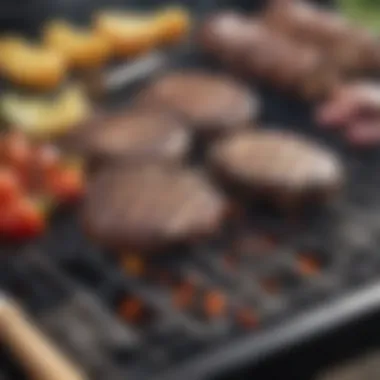
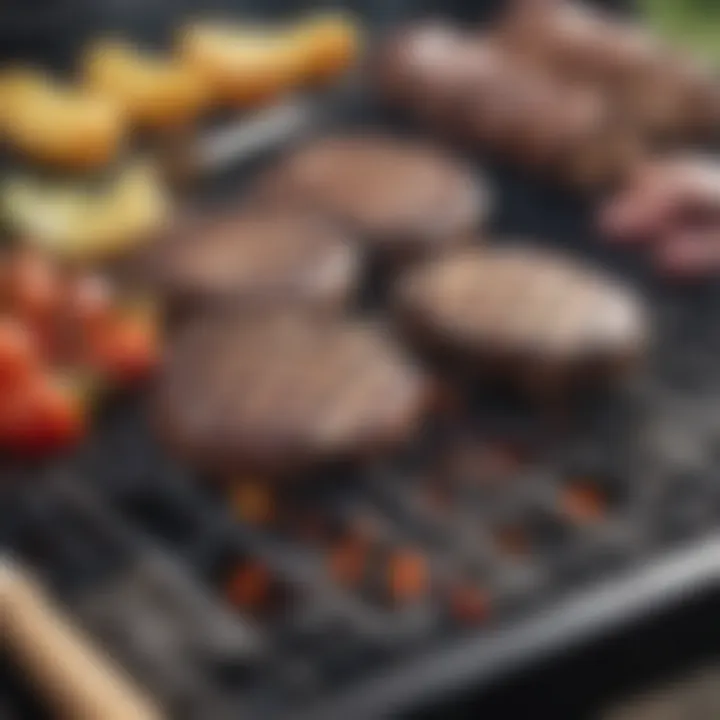
A charcoal chimney's unique feature is its ability to concentrate heat from the coals at the bottom, which promotes uniform ignition of the entire batch. While this method is popular and reduces chemical taste, the chimney can pose a risk of burns if not handled with care. Therefore, investing in a good charcoal chimney not only speeds up the process but also makes lighting your grill simpler and cleaner.
Heat-Resistant Gloves
Heat-resistant gloves are another critical piece of equipment, safeguarding your hands from the intense heat associated with grilling. The key characteristic here is the material—most are made from silicone or aramid fibers, both designed to withstand high temperatures.
These gloves offer a beneficial layer of protection, allowing a confident handling of the grill, lid, and tools without the risk of burns. Their unique feature often includes a non-slip grip, making it easier to manage hot items. However, one disadvantage could be that some gloves can be bulky, potentially hindering DIY grilling maneuvers. Overall, heat-resistant gloves enhance safety and provide peace of mind during your grilling sessions.
Cleaning a Charcoal Grill
Removing Old Ash
Cleaning, particularly in the form of removing old ash, is vital for preparing a charcoal grill before cooking. The significance of removing old ash is twofold: it prevents any leftover ash from interfering with airflow and allows for better heat distribution.
A key characteristic of this task is that it ensures your grill runs efficiently. This process is beneficial for achieving consistent burning since leftover ash can block airflow and lead to uneven cooking. A unique feature of good charcoal grills includes ash catchers that make this task a breeze. On the downside, not cleaning sufficiently can lead to build-up and odors. Thus, incorporating this cleaning step into your routine ensures a fresh start for every grilling adventure.
Scrubbing the Grate
Scrubbing the grate is another indispensable task when preparing your grill. The key characteristic of this action is its role in maintaining hygiene and food quality. A clean grate prevents old flavors from mingling with new, providing a pure taste for your food. Consistent scrubbing not only removes residues but also helps in preventing corrosion of the grate material.
The benefit of regular scrubbing is that it reduces the use of oil when grilling and minimizes the risk of food sticking. Unique grill brushes, often featuring brass or nylon bristles, make this task efficient. However, using the wrong tool can scratch and damage a non-stick surface. Overall, scrubbing your grate keeps your grilling surface clean and allows the flavors of your food to shine.
Starting the Charcoal
Starting the charcoal is a pivotal step in the art of grilling. It's where the magic begins, and the importance of this section lies in ensuring that you facilitate a smooth and efficient ignition process. Without properly starting your charcoal, flavorful meals may end up as just a pile of undercooked disappointment. Understanding the nuances of lighting charcoal not only enhances safety but also affects the overall taste of your grilled dishes.
Choosing the Right Charcoal
Choosing the right type of charcoal is crucial to kick off your grilling session on the right foot. Different charcoals have unique burn times and heat intensities, which can greatly impact your cooking. Natural lump charcoal is often favored for its ability to light quickly and burn hotter than briquettes, making it an excellent choice for high-heat grilling.
Some people may lean towards briquettes for their uniform size, which can provide consistent heat. However, they often contain additives that can affect flavor. When selecting charcoal, consider what you're grilling and how long you plan to cook. The right choice can mean the difference between culinary triumph and failure.
Utilizing a Charcoal Chimney
Filling the Chimney
Filling the chimney is about more than just throwing charcoal inside; it's a strategic step that determines the efficiency of your setup. By using a chimney starter, you're ensuring even lighting and preventing hot spots that could ruin your food. The key characteristic of this device is its design – it encourages airflow, allowing the charcoal to ignite rapidly. It's a favorite among grilling enthusiasts because it simplifies the process. The unique feature of a chimney starter is that it holds the charcoal vertically, which enhances heat circulation. This aspect is particularly beneficial for achieving that perfect, even burn that every cook aspires to.
Lighting the Charcoal
Lighting the charcoal properly is where the excitement really begins. Once your chimney is filled, it's time to awaken the coals. Using crumpled newspaper or natural fire starters, you can ignite the charcoal from underneath. The defining feature of this method is its reliability; once lit, the flames can engulf the entire pile, ensuring all coals reach optimal temperature uniformly. This method is often seen as beneficial because it avoids the use of lighter fluids, which can impart unpleasant chemical flavors to your food. Lighting the charcoal using a chimney can produce consistent, high heat that’s essential for perfect grill marks and a nice sear on your meats.
Timing and Monitoring
While the flames dance, it's crucial to pay attention to timing and monitor the heat buildup. This is where a good grilling experience can go sideways if not managed properly. The key here is patience; allowing the charcoal to reach a gray ash state is essential for optimal grilling. Monitoring helps you understand how long it takes for your charcoal to reach ideal cooking temperatures. A unique advantage of keeping an eye on the fire is the ability to control heat levels throughout the grilling process, which is vital for multi-zone grilling.
Alternative Lighting Methods
Liquid Charcoal Lighter
Liquid charcoal lighter is another method that some grillers opt for due to its simplicity. It's a quick way to ignite coals, especially for those in a rush. The characteristic of this lighter is its ease of use; just apply it to your charcoal, light, and you're off to the races. However, this choice comes with a caveat: the chemicals may affect your food’s taste. While it’s beneficial for speed, the potential for flavor interference may not sit well with purists.
Fire Starters
Fire starters provide yet another alternative to kickstart your grilling. These items burn efficiently and are designed to be safe and easy to use. A characteristic of fire starters is that they generate heat gradually, which can evenly light your charcoal over time. This method is popular among those who prefer not to rely on chemical lighters. However, care should be taken to ensure they are made from non-toxic materials to avoid any unwanted flavors in your food. The unique aspect of fire starters is their versatility – they can be used for various types of grills, ensuring a successful ignition.
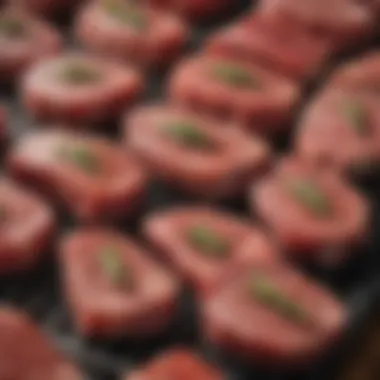
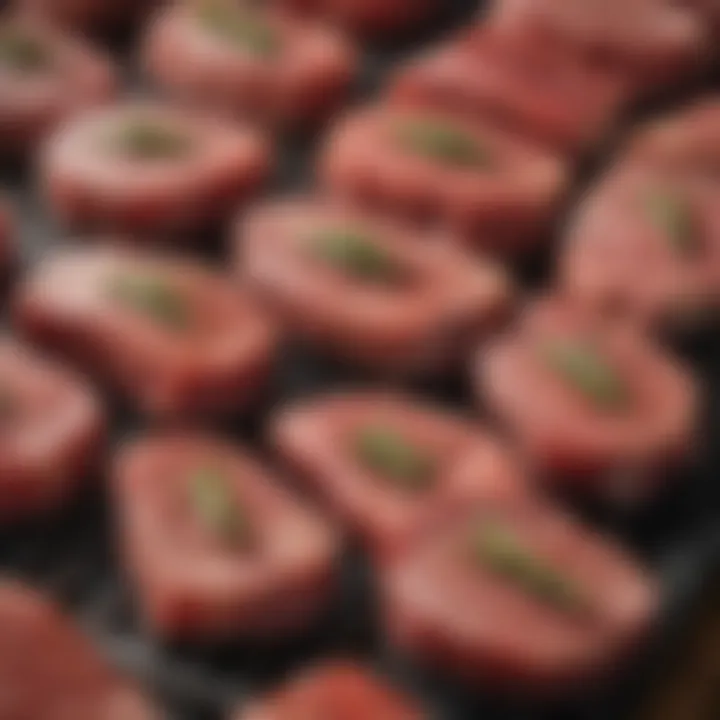
Achieving the Right Temperature
When it comes to charcoal grilling, achieving the right temperature is as essential as the charcoal itself. Depending on your cooking ambitions—be it smoky ribs or succulent veggies—the level of heat will dictate not only the cooking time but also the texture and overall taste of your food. Mastering temperature not only ensures that your meals are delicious but also safe to eat.
Understanding Temperature Ranges
Direct vs. Indirect Heat
Understanding the difference between direct and indirect heat is like knowing the difference between a sprint and a marathon; both have their purpose, and when applied correctly, can yield excellent results. Direct grilling applies heat straight from the charcoal to the food, making it a prime choice for quick-cooking items like steaks or burgers. You can easily achieve that coveted char and those signature grill marks.
On the flip side, indirect grilling redistributes heat. The charcoal sits on one side of the grill, while the food cooks on the other, away from the flames. This method is best for larger cuts of meat that need a slower, more uniform cook. A crucial advantage of indirect heat is that it helps in cooking delicate foods without the risk of burning. Both techniques require skill, and the choice depends heavily on what you aim to create on your plate.
Temperature Control Techniques
Temperature control techniques can be thought of as the conductor of an orchestra. This ensures that every element of your grilling experience comes together harmoniously. Maintaining the right heat level allows you to uncover unique flavors in your food and helps transform what could’ve been a dry piece of chicken into a moist, flavorful delight.
The most effective technique involves adjusting air flow by managing the grill vents. Opening the vents up allows more oxygen in, ramping up the heat, while closing them down lowers it. In addition, you can use a water pan or place your meat on the cooler side of the grill to aid in temperature management, especially for long cooks. This gives you more control over your grilling, making it a productive endeavor you can truly enjoy.
Using a Grill Thermometer
Using a grill thermometer can be a game changer. Much like a seasoned chef who relies on their senses, a thermometer transcends guesswork. This handy tool lets you accurately track the internal temperature of your food, ensuring that it hits those ideal numbers. For instance, cooking poultry to 165°F secures its safety, while a juicy steak thrives at around 135°F.
With digital options available, monitoring temperature becomes as straightforward as can be—eliminating the stress of over or undercooking. Remember, good grilling isn’t just about the right char; it’s about knowing what’s going on beneath the surface. Getting a dependable thermometer can make all the difference. The peace of mind it provides is worth its weight in gold.
Grilling Techniques
Grilling techniques play a pivotal role in the overall success of using a charcoal grill. Mastery in these methods not only elevates the flavor but also enhances the overall grilling experience. Understanding the various approaches and their effects on cooking can greatly influence the quality of the dishes prepared. Here’s a deep dive into some essential techniques.
Common Grilling Methods
Direct Grilling
Direct grilling is fundamentally all about cooking food over high heat. This method is particularly effective for quick-cooking items such as burgers, hot dogs, and thin cuts of meat. The key characteristic of direct grilling is the intense, radiated heat from the charcoal, which allows for a fantastic sear and caramelization that many grill enthusiasts cherish. It’s a popular choice among cookout aficionados simply because it delivers great results in a matter of minutes.
However, while direct grilling offers these benefits, it can also lead to uneven cooking, especially for thicker items; this can sometimes burn the outside while leaving the insides undercooked. Proper management and flipping of the food are crucial to achieving that perfect char without overdoing it.
Indirect Grilling
On the flip side, indirect grilling involves placing food away from the heat source. This method is perfect for larger cuts of meat such as roasts or whole chickens, where slow cooking is necessary to achieve tenderness without drying out the outside. The essential characteristic of indirect grilling is that it allows heat to circulate around the food, much like an oven. This provides a gentle cooking environment, which is key to achieving juicy results.
Indirect grilling is particularly beneficial when aiming for smoky, deep flavors. However, one must keep an eye on the fuel, as the charcoal can need more replenishing than with direct grilling, where heat is more localized. The patience required for this technique often pays off with extraordinarily tender and flavorful meals.
Grilling Different Types of Food
Meat
Meat is undeniably a star player on many grilling menus. The key to successfully grilling meat lies in understanding its various properties and optimal cooking times. Whether it’s steaks, chicken, or ribs, using the right technique is essential for enhancing those rich, savory flavors. For instance, almost any meat benefits from marinating - this not only infuses flavor but also helps in tenderizing tougher cuts. Meat is generally easy to handle on a grill, and with proper techniques, it acquires a delightful char while retaining juiciness. However, one must be mindful of cooking temperatures; overcooking can lead to dryness.
Vegetables
Vegetables, often overlooked in grilling, can offer an incredible burst of flavor when treated correctly. They typically have a higher water content than meats, which can lead to mushiness if cooked improperly. The distinct advantage of grilling vegetables is that the high heat allows for delicious caramelization, enhancing their natural sweetness. Techniques like using skewers or baskets can make it easier to manage smaller or delicate pieces. Regardless, careful timing is essential, as testing for doneness is crucial to prevent charred bits overshadowing the fantastic taste.
Fruits
Surprisingly, many don’t consider fruits for grilling. However, grilling can transform them into an extraordinary treat. Certain fruits like pineapples, peaches, or watermelon bring out hidden flavors when slightly charred. The process works similarly to vegetables—quick, high heat enhances flavor, resulting in sweetness that complements savory dishes remarkably well. Fruits are best when they’ve med high sugar content, as this encourages caramelization to promote a satisfying texture.
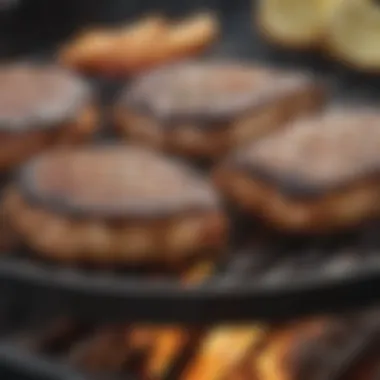
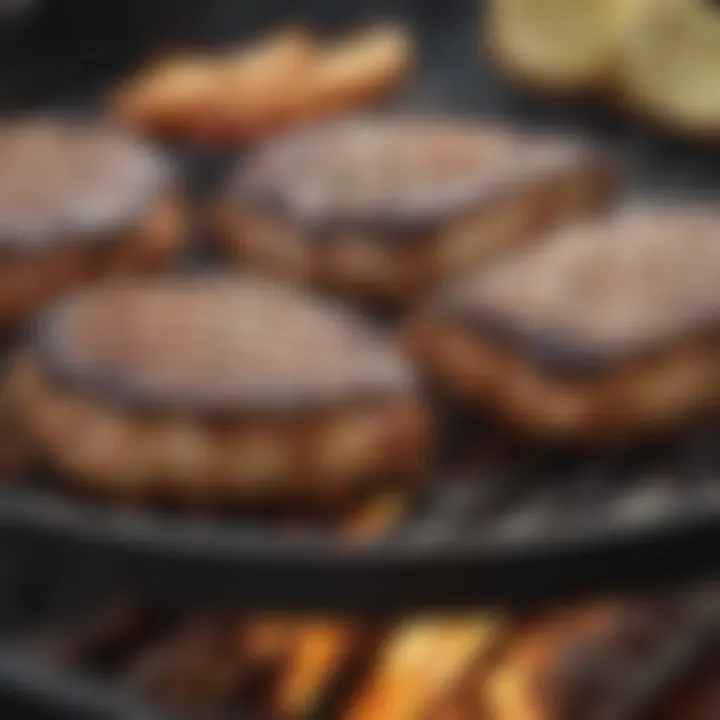
Enhancing Flavor with Wood Chips
To amp up the flavor during grilling, wood chips can be added to the charcoal. Soaking the chips in water prior to grilling is beneficial to ensure a slow release of smoke, which infuses food with a unique taste. Chips from different trees—like hickory, mesquite, or applewood—can yield distinctive flavors, and experimenting with these can bring creativity to the grilling process. Each type brings its own personality to the dish, allowing cooks to tailor their flavor profiles to match specific meals.
Safety Considerations
When it comes to charcoal grilling, safety should always be top of mind. Understanding potential hazards not only protects you but also enhances the overall grilling experience. Charcoal grills can be a joy to use, but if proper safety measures are overlooked, it can quickly turn into a recipe for disaster. The importance of adhering to safety guidelines can't be stressed enough, as doing so can prevent injuries, property damage, and creates a more enjoyable environment for creating meals.
Fire Safety Tips
Using charcoal presents unique fire risks that must be managed proactively. Here are some fundamental tips:
- Choose an appropriate location: Always place your grill on a flat, non-flammable surface away from buildings, trees, and other flammable materials. Having it too close to structures can lead to unfortunate accidents.
- Monitor the grill: Never leave a lit grill unattended. It only takes a moment for something to go wrong. Keep an eye on your setup at all times.
- Use a fire extinguisher: Having one nearby that is rated for grease and electrical fires can make a huge difference in an emergency.
- Know your charcoal: It's often tempting to add lighter fluid or similar substances to an already lit grill, but that’s a no-go. It can cause unexpected flare-ups and create a hazard.
"A little caution goes a long way; grilling should be fun, not a hazardous undertaking."
Handling Charcoal Safely
Proper handling of charcoal is essential for preventing burns or other injuries during your grilling sessions. Here’s how to manage charcoal like a pro:
- Wear protective gear: Heat-resistant gloves and long sleeves can protect you from burns while managing hot coals. Don't underestimate the heat intensity that charcoal generates.
- Use tools: Instead of bare hands, utilize tongs or tools designed for grilling to handle hot coals. This keeps distance between you and the heat.
- Avoid water on hot charcoal: If you need to cool down your grill, avoid using water on hot coals, as this can cause steam and hot ash to fly, which might lead to burns or startle you.
- Dispose cautiously: After grilling, allow the charcoal to cool completely before disposing of it. Store ashes in a metal container with a lid until you are certain they are cool to prevent any chance of fire rekindling.
In essence, maintaining safety while charcoal grilling safeguards not only your well-being but also the overall enjoyment of this popular cooking method. With a balanced approach towards safety, your grilling endeavors can remain fulfilling, delicious, and—most importantly—risk-free.
Finishing Up and Cleanup
After a delightful grilling experience, the finishing touches might be the last thing on your mind. Yet, wrapping things up properly is as crucial as the grilling itself. This part ensures not just the longevity of your grill but also guarantees a safe and sanitary cooking environment for your next round of barbecue. Effective cleanup can save you from pesky pests, eliminate bad odors, and lower maintenance costs in the long run.
Letting the Grill Cool Down
Before diving into cleaning, one must let the charcoal grill cool down to a safe temperature. This step is often overlooked but is vital for preventing burns and accidents. After you finish grilling, simply close the grill’s vents. This action reduces airflow, leading to a decrease in fire intensity, allowing the embers to smother themselves.
Benefits of Cooling Down:
- Prevents burns when handling the grill.
- Reduces risk of fire hazards from hot coals.
- Makes cleaning easier once the grill is at a manageable temperature.
As you wait, perhaps enjoy the company of your guests, or reflect on the splendid meal just prepared. Letting the grill cool naturally takes some time, but it is worth the wait.
Proper Disposal of Charcoal Ash
When the grill is cool, it’s time to tackle the ashes. Proper disposal not only promotes safety but aligns with environmental considerations. Used charcoal ash can be alkaline and contains chemicals that may harm the environment if not disposed of responsibly.
Disposal Steps:
- Gather Tools: Use a metal scoop or a shovel for transport. Avoid plastic tools, as they can melt from residual heat.
- Contain the Ash: Store the ash in a metal container with a lid. It’s advisable to wait 24 hours after grilling before handling to ensure all remnants are cool.
- Disposing Options:
- Check Local Regulations: Many places have specific guidelines for ash disposal.
- Garden Uses: Ash can be beneficial for the garden, acting as a fertilizer or pest deterrent.
Cleaning Your Grill After Use
Cleaning the grill is not merely an act of hygiene; it’s a declaration that you respect the cooking process. Regular cleaning can prolong the life of your grill and keep those delicious flavors intact for future meals.
Cleaning Checklist:
- Scrub the Grate: Once the grill cools down, it’s important to scrub the grate while still warm. A stiff wire brush works wonders for removing food residue.
- Wash the Interior: Clean the inside of the grill with soapy water and a sponge. Use vinegar for tough stains and odors.
- Maintain the Exterior: Wipe down the outside with a gentle cleaner. Stainless steel requires specific cleaners to avoid streaks.
Additional Tips:
- Avoid harsh chemicals: Products with strong fragrances may linger and affect the taste of your food.
- Routine Maintenance: Establish a cleaning routine after every grilling session to keep tasks manageable.
Final Thought: Remember, a clean grill is a happy grill! Taking the time to clean and properly store your grill not only preserves the quality of your past cookouts but also sets you up for success with every grilling effort in the future.







